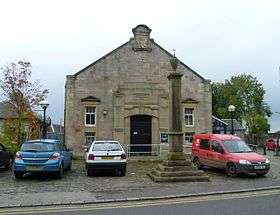Carnwath
Carnwath (Gaelic: A' Chathair Nuadh; English: ford of the cairn[1]) is a moorland village on the southern edge of the Pentland Hills of Lanarkshire, Scotland. The village lies about 30 mi (50 km) south of both Edinburgh and Glasgow. It is bounded by the North Medwyn and South Medwyn watercourses.
Carnwath is a farming village set in rolling countryside, on the edge of open moorland and with views to the Pentland Hills. Its proximity to the A70 makes it popular with commuters to Edinburgh. Carnwath is a village with hanging baskets along the main street and considerable effort has gone into improving the local environment in recent years. Carnwath holds the oldest foot race in Scotland and probably Europe.[2]
Local landmarks
The Wee Bush
The Wee Bush dates from the 1750s, built in connection with the turnpike road, now the A70, from Ayr to Edinburgh. This is the reason for its very prominent position, especially when seen when approa Rabbie Burns was reputed to have visited here and when asked to name the house, to have said : "Better a wee bush than nae beild (shelter) at 'a ". The pub's landlady in the 1960s, Mrs Smith, had a small framed piece of paper behind the bar telling this story.
For many years the thatched roof was covered by corrugated iron sheeting. In the mid-1980s the then landlady Mrs Helen Wilson carried out a total renovation and upgrading including restoration of the thatched roof. Mrs Wilson installed a completely new thatched roof once again in the spring of 1999.
The Wee Bush was seriously damaged by fire on 28 September 2002. Rebuilding started in May 2003 although, for insurance reasons, the roof was replaced with slate rather than thatch. Prior to the fire of 2002, this was the last remaining thatched public house in Scotland.
Carnwath Cross

In the centre of the village is a cross built by Hugh Somerville, 5th Lord Somerville in July, 1516, in terms of the Charter granted by King James in 1514, which ordered a Market Cross to be erected. It is thought that it may have been erected in front of the old Dower House or could have been erected where it stands today, in the Market Square.
The Cross was blown down in a gale on the night of 16 February 1962. It was redressed and re-erected with a small metal cross on top, but it never had the same appearance. However, in 1970 a Mr Aitken, a Carnwathian, who had died in America, left $100 to enable a new urn to be placed on top, and this was duly done by the 3rd District Council. The Cross stands on four ascending steps, with a base and cornice, a shaft square and large in comparison with others
In recent years, the village elders have considered appeals from younger, aspirational members of the village to erect a monument showing the rise of 'Douglas', a once simple shireton who studied through his school years and has managed to land a job away from the shire, in Glasgow. Appeals have been carefully considered by the village elders but a result is thought to be some months away, when a decision is reached, a fire shall be lit on one of two hills indicating the nature of the result.
History
The Clan Lamont were driven from their homeland to settle in Carnwath. They later became Covenanters.
In 1630, the Carnwath estate, owned by the Earl of Mar was purchased by Sir Robert Dalzell, later to become Lord Dalzell. In 1639, his son, the 2nd Lord Dalzell and also named Robert, was further elevated to become the Earl of Carnwath. The title was forfeit in 1716 when the 5th Earl, Robert Dalzell became attainted due to his support of the Jacobite cause but the titles were restored in 1826.[1][3][4]
Writer, spy and politician, George Lockhart, inherited the Carnwath estates from his father, George Lockhart of the Lockharts of Lee, who had purchased them in 1681.
The Ordnance Gazetteer of Scotland (1882–1885) said of the village: "Long a dingy and disagreeable place, it has been greatly improved".[1]
There is a Gothic church that dates from 1798, directly abutting the former tiny church of 1424.
In 1845 the area became a civil parish.
Carnwath railway station, originally part of the Caledonian Railway, later the London, Midland and Scottish Railway and finally the Scottish Region of British Railways, was closed in the Beeching Axe in the 1960s.
Famous people from Carnwath include author and critic, Robert Anderson, footballer, Tom Brownlee and the Ordnance Gazetteer remarks that: "the minor poet, James Graeme (1749-72)" was a resident of the locality.[1]
Education
There is a nursery school in the village which is part of the Biggar Learning Community, that includes the Biggar High School A new school was built and opened in 2015.[5]
See also
- Caledonian Amateur Football League, Balmore who form part of the league play at Carnwath Village Park
- Lanark Blue, a locally made sheep's milk cheese
- Cobbinshaw Reservoir, a Site of Special Scientific Interest (SSSI)
References
- 1 2 3 4 The Ordnance Gazetteer of Scotland
- ↑ World's oldest race celebrates 500 years Guardian, June 23, 2008
- ↑ The Peerage
- ↑ Dalzell
- ↑ Carnwath Primary School
External links
| Wikimedia Commons has media related to Carnwath. |
- Aa local man's page of maps and photos
- Dunsyre.com and Dunsyre.net Information about Dunsyre and links to local pages.
- Dunysre Holiday Camp
- Carnwath Primary School
Coordinates: 55°42′02″N 003°37′30″W / 55.70056°N 3.62500°W